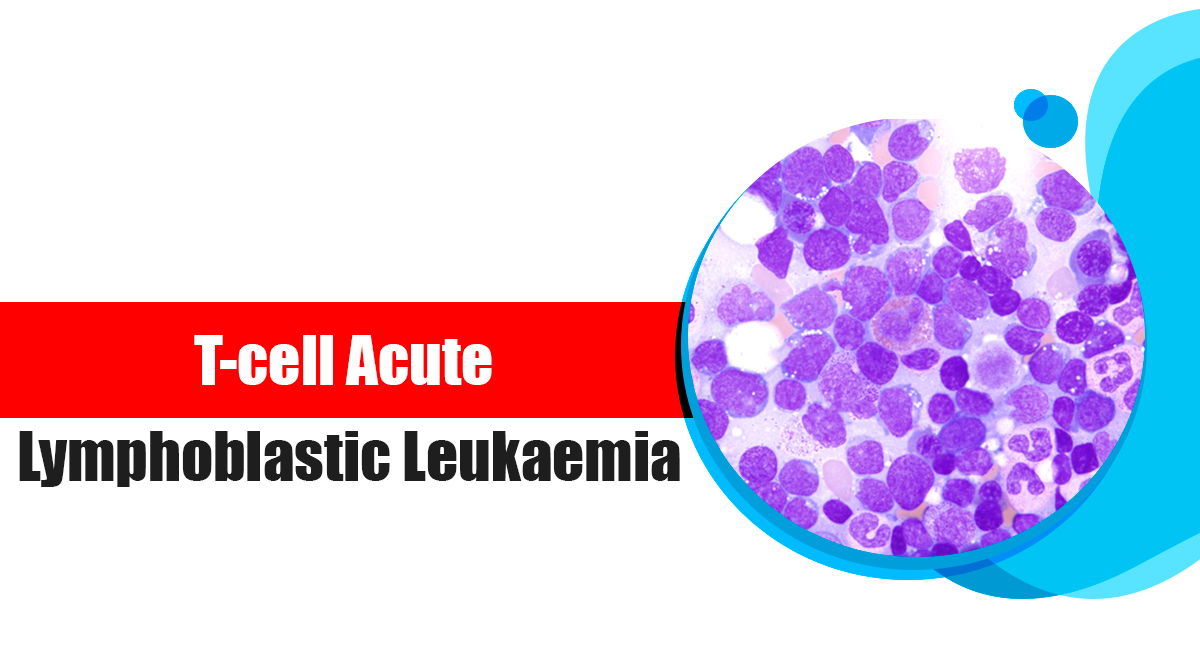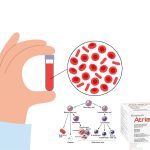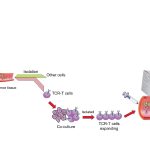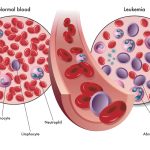T-cell acute lymphoblastic leukaemia also known as T-ALL is a specific type of leukaemia. It is a variant of acute lymphoblastic leukaemia (ALL), with features identical to some types of lymphoma.
T-cell acute lymphoblastic leukaemia (T-ALL) is aggressive and progresses rapidly. It is known for affecting the lymphoid-cell-producing stem cells, in particular a type of WBC named T lymphocytes as opposed to ALL (acute lymphoblastic leukaemia) which typically affects B lymphocytes.
A lymphoid stem cell becomes a lymphoblast cell and then 1 of 3 types of lymphocytes (WBCs):
- B lymphocytes that create antibodies to help fight infection.
- T lymphocytes that help B lymphocytes create the antibodies that help fight infection.
- Natural killer cells that attack malignant cells and viruses.
Causes of T-cell Acute Lymphoblastic Leukaemia)
In most cases of T-cell acute lymphoblastic leukaemia there is no obvious cause but it is crucial to understand that:
- It is not contagious
- It is not inherited
Risk Factors:
Age: Studies show that most forms of leukaemia are a bit common in older individuals. The major exception to this is acute lymphoblastic leukaemia, in which peak incidence is in children, aged between about 2-5 years. T-cell acute lymphoblastic leukaemia is most common in slightly older children.
Being male: T-cell acute lymphoblastic leukaemia affects males more than females at all ages.
Signs and Symptoms of T-ALL
There are no specific signs/symptoms which would allow a diagnosis of T-cell acute lymphoblastic leukaemia to be made. The most common signs/symptoms are caused by the bone marrow being not able to develop appropriate normal blood cells.
- Anaemia: because of lack of RBCs
- Tiredness, weakness, shortness of breath, light-headedness, palpitations
- Infections: because of normal WBCs
- Infections are a bit more frequent, more severe and last longer
- Malaise (general feeling of illness), fever and sweats
- Bleeding gums, purpura (small bruises in skin), nosebleeds
- Bleeding and bruising: because of lack of platelets
Certain other possible common signs and symptoms may include:
- T-cell acute lymphoblastic leukaemia often causes swollen lymph nodes in the middle portion of the chest (mediastinum) which may be responsible for affecting breathing or the circulation.
Diagnosis of T-ALL
Perhaps a health specialist may suspect a patient has leukaemia on behalf of signs and symptoms, but it can only be diagnosed by certain laboratory tests.
Outcomes of simple blood counts typically demonstrate leukaemia although, rarely, a blood count may be normal. Virtually all patients with T-cell acute lymphoblastic leukaemia will have bone marrow samples considered to confirm the diagnosis and to help to specify exactly what kind of leukaemia a patient has.
More specialised tests are often performed at the same time. Usually, a chest x-ray will be taken and also scans, in order to look for swollen lymph nodes, or other possible affected sites.
Blood samples will be considered to test for any problems with the kidneys, liver or other organs. In ALL a sample is considered of the fluid which surrounds the brain and spinal cord – cerebrospinal fluid (CSF). This is because the cells of ALL can get into the nervous system, which protects them from maximum sorts of treatment. This is more common in T-ALL.
Certain blood tests as well as scans will be repeated in order to check for treatment response and any other complications. Certain other tests are usually only performed at the time of diagnosis. Other tests which can be performed may include:
- Lumbar Puncture: a sample of fluid (CSF) from around the spine – In order to show whether there are leukaemia cells in the nervous system.
- X-rays, Ultrasound or Scans (CT or MRI): In order to monitor impact on organs of the body.
Blood tests, bone marrow samples and lumbar punctures will be repeated throughout therapy in order to monitor response.
Staging for T-cell Acute Lymphoblastic Leukaemia
Staging is not used for T-cell acute lymphoblastic leukaemia, because it is spread throughout the body when initially diagnosed. There is a system to classify T-cell acute lymphoblastic leukaemia as high-risk, standard or low-risk. It is crucial to stress that this refers to the chance of a better response giving standard treatment. If treatment is selected as per the risk group, numerous patients with high-risk disease will do very well. It is also, unfortunately, not always true that an individual with reduced risk disease will do well. The risk group is only of the factors which affect the results of treatment. Maximum cases of T-cell acute lymphoblastic leukaemia are classed as high-risk; with apt treatment they have a better chance of successful treatment.
Treatment of T-cell Acute Lymphoblastic Leukaemia
In case you are being treated for any kind of leukaemia, you may be asked to consider taking part in a clinical trial. Clinical trials specifically are scientific studies in order to find the best treatment. Virtually all patients with T-cell acute lymphoblastic leukaemia will initiate treatment promptly. The major exception would be in case a patient is very ill with any other medical complications and is not fit enough to get treatment.
The acute leukaemia is often curable with the help of standard treatments, in younger and/or fitter patients. Older or less fit patients will usually have a good initial response to treatment but the disease will most often come back, this is called relapse. The particular ways in which the leukaemia is treated are:
- Chemotherapy: Cell-killing medicines. Steroids are normally recommended in combination with chemotherapy for T-ALL
- Radiation therapy: Usually only given as part of a stem cell transplant in T-ALL
- Stem cell transplant: Younger/fitter patients may be given a stem cell transplant (bone marrow transplant). This is performed using healthy stem cells from a donor. This is performed for T-ALL in case chemotherapy does not cure the disease.
Role of Nelarabine in the Treatment of Acute Lymphoblastic Leukemia (ALL)
In the month of October, 2005, the Food and Drug Administration granted accelerated approval for nelarabine 250 mg for the treatment of patients with T-cell ALL (T-ALL) and T-cell lymphoblastic lymphoma. (T-LBL) in whose the disease had not responded to or relapsed after treatment with at least 2-chemotherapy regimens.
Adding the drug nelarabine 250 mg (atriance) to standard chemotherapy help improves survival for children as well as young adults newly diagnosed with T-ALL (T-cell acute lymphoblastic leukemia), as per the new outcomes from an NCI-sponsored Children’s Oncology Group (COG) clinical trial.
How does nelarabine work?
Nelarabine falls under the group of drugs named antineoplastics. It is believed to interfere with the progression of cancer cells, which are at the end destroyed. Since the progression of normal body cells may also be affected by nelarabine, some other effects will also appear. A few of these may be severe and must be reported to a health specialist. Other effects may not be severe, but may be responsible for causing concern.
How much does nelarabine injection cost?
The nelarabine injection cost is reasonable and expected to vary depending on certain generic and brand-name medicines. The generic versions tend to cost absolutely less in comparison to their available brand-name alternatives. Nelarabine supplied under the brand Atriance and 250 mg dosage strength. In order to procure atriance 250 mg in India at the most promising price range, kindly connect to us at TOLL-FREE Number: 1800-889-1064. We’re legitimately engaged and are certified by WHO-GDP & ISO in order to supply best Quality atriance injection in India.






